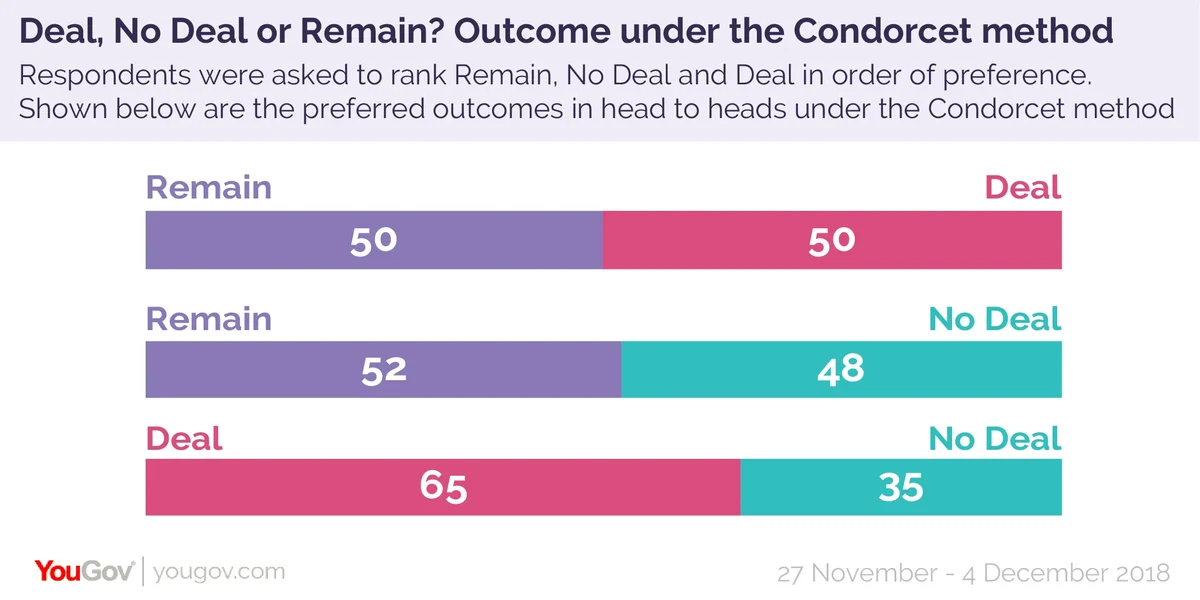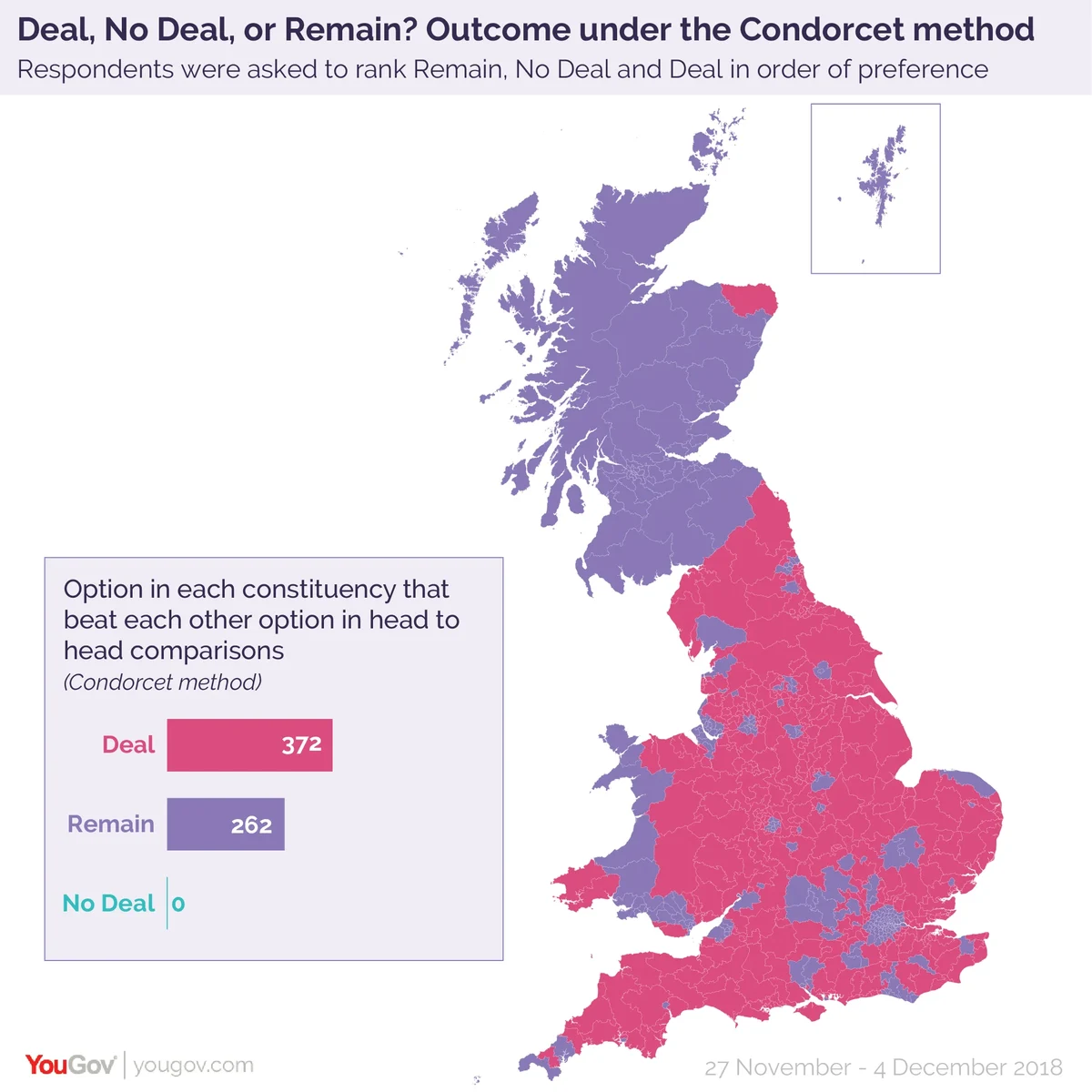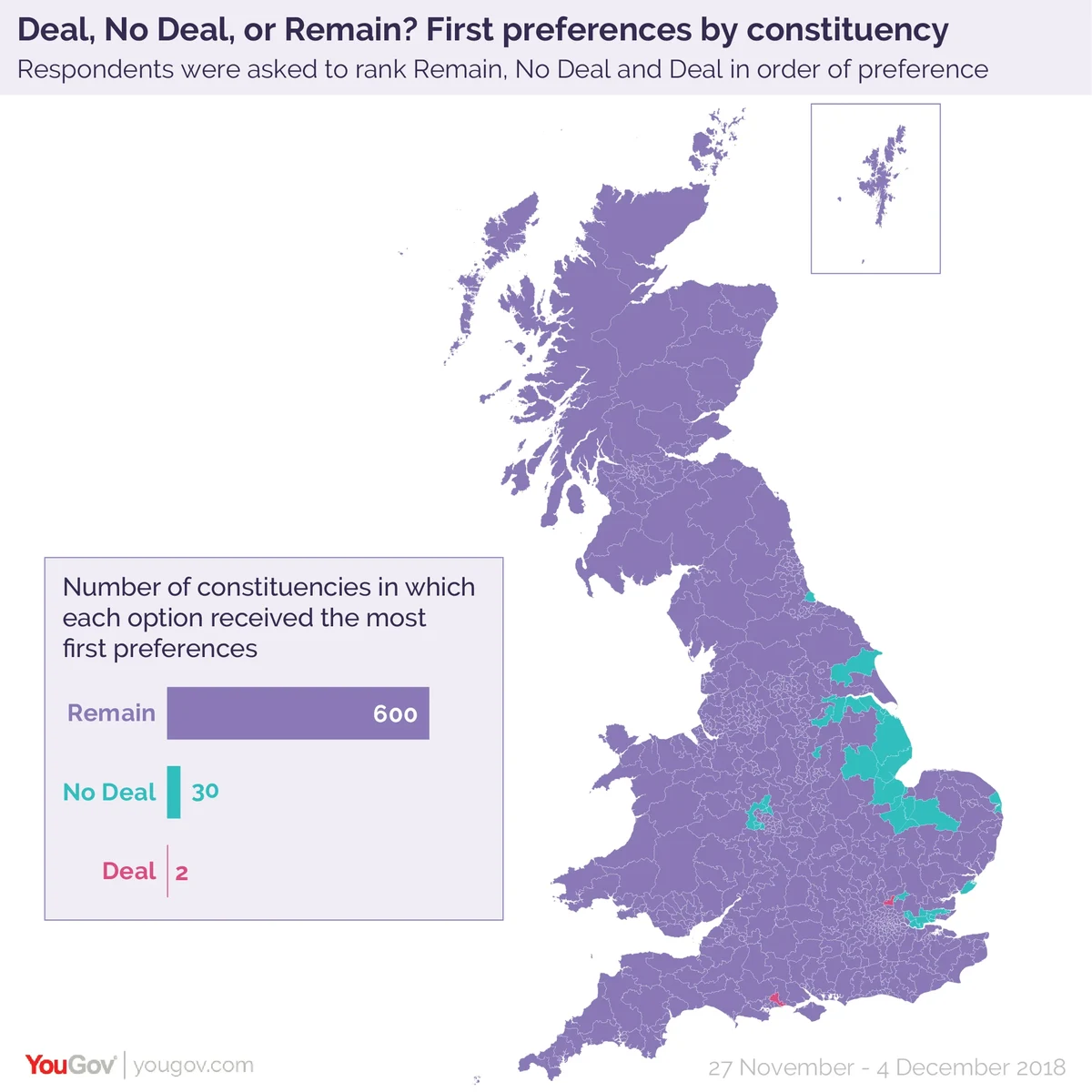A new YouGov MRP model examines which Brexit option each constituency prefers
Last month Theresa May delivered a stark ultimatum to MPs: her deal, no deal, or have no Brexit.
But what do voters think and how does it specifically translate to the MPs currently deciding the fate of the Withdrawal Agreement in the House of Commons? We tested how the public views these different Brexit outcomes using MRP constituency modelling, the same method which delivered near-perfect projections of a hung parliament in the 2017 general election. Between 27 November and 4 December we have interviewed 20,910 people in Britain, one of the largest surveys on Brexit to date.
We asked them to rank the Deal/No Deal/Remain options in order of preference. The results show that as things stand, when it comes to their first choices Theresa May’s deal is ahead in just two constituencies – the Tory-held constituencies of Broxbourne and Christchurch, and gaining just 27% across Britain.
That puts it behind Remain – which has 46% support nationally and is first preference in 600 constituencies – and level pegging with No Deal (also 27%), although No Deal is first choice in 30 seats. This model excludes the 12% of people who said they don’t know.
These figures suggest that the Prime Minister is fighting a similar problem among the public at large as she is among her fellow MPs. While a chunk back her deal as a compromise, she is having to fight opposition to the deal on two flanks.
On the Leave flank, our modelling shows that well under half (40%) of those who backed Brexit in the referendum support her deal, while the majority (51%) prefer No Deal. On the Remain flank, just 13% of those who supported staying in the EU in 2016 back the deal, with the vast majority (83%) still favouring Remain.
This is why on a constituency basis in a three-way fight the Withdrawal Agreement currently before parliament doesn’t fare too well when pitted against the two other less compromising choices.
However, whist May’s deal is supported by just over a quarter of the public, the simple fact is that there is no majority support for any of the three options we presented, meaning that in order to find what outcome would gain majority support we should also look beyond the public’s first preferences.
And when the battle is turned from a three way split, where no compromise is needed, into straight two-way fights, Theresa May’s deal starts performing a lot better.
One way of analysing this is to use the “Condorcet method”. With this approach, instead of looking for which option is most people’s first choice, we should instead test which one beats all the others in a head-to-head fight. We do this by removing each option in turn, and then looking at the second choice of people who backed that option.
When we remove the Deal as an option and reallocate these preferences in a straight Remain Vs No Deal contest we find that Remain would be slightly ahead, winning 52% to 48%.
If the Deal is pitted against No Deal, the majority of Remainers swing behind what Theresa May is proposing, meaning it wins 65% to 35%. The calculation for Remain vs the Deal is a lot tighter. Although the vast majority of no dealers swing behind May’s plan, because Remain begins from a much higher starting point the result is a statistical dead heat – with 50% for each option.
(The model actually shows Remain ahead by a few decimal points, technically making it the Condorcet winner, but this is well within the margin of error, and when rounded it gives an even split).

But while this is all well and good at a national level, next week’s vote will take place in the House of Commons. How do MPs constituencies break down in the two-way fights of the Condorcet method? The model finds that a majority of constituencies – 372 in total – would choose the Deal (these are seats where it beats both No Deal and Remain), while a minority – 262 – back Remain (these are constituencies where Remain beats both No Deal and Deal). Under this approach no seats support a No Deal Brexit.

Still using the Condorcet method, 260 of the 317 constituencies that returned a Conservative MP in 2017 back the Deal, compared to just 57 that choose Remain. If only Tory supporters were to vote in these Conservative-held seats, the Deal would win in every one.
Among all voters in the 262 Labour-held seats things are more evenly split. Remain is the preferred option in 152 constituencies with 110 backing the Deal. Remain also comes out on top in all 53 seats held by other parties (including all of the 35 constituencies held by the SNP). In a mirror image of Tory voters in Conservative constituencies, if only Labour voters were to choose in each of the party’s 262 constituencies, Remain would win every one.
As she prepares for next Tuesday’s vote it seems that Theresa May’s deal faces the same problems amongst the public as she does among MPs. Whilst it may be more successful in head to head battles, against both No Deal or Remain, it is struggling to fight on both flanks at the same time.
Photo: Getty











